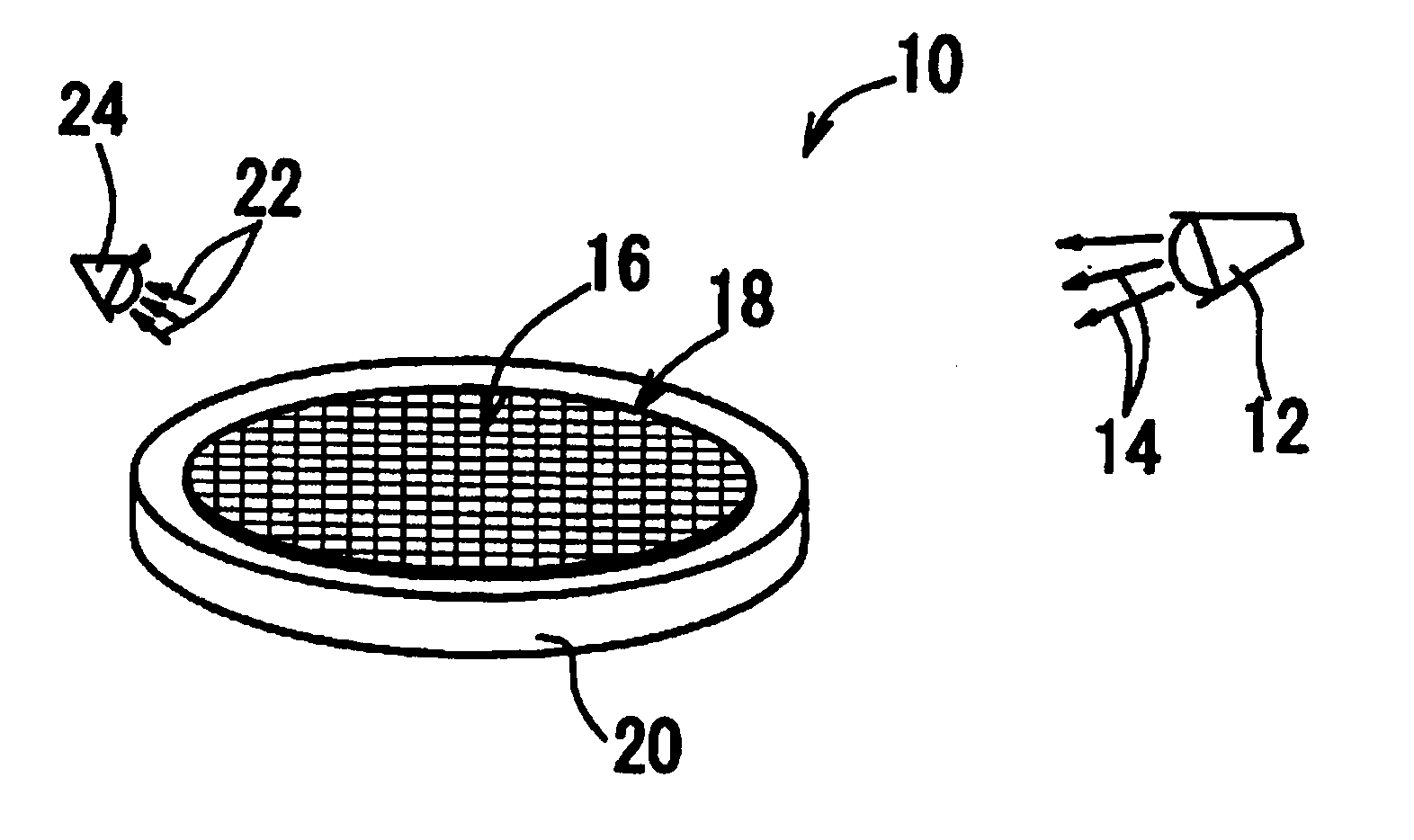Illuminator for macro inspection, macro inspecting apparatus and macro inspecting method
a macro inspection and microscope technology, applied in the field of photolithographic process, can solve the problems of resist pattern deformation, multi-lot loss, and microscopic detection, and achieve the effect of reducing the number of lots
- Summary
- Abstract
- Description
- Claims
- Application Information
AI Technical Summary
Benefits of technology
Problems solved by technology
Method used
Image
Examples
example 1
First, a light source which is suitably used for visual inspection for defocused parts was selected. Since the intensity that human can perceive is an integral value obtained by spectral luminance efficiency shown in FIG. 8 and spectral characteristic of the light source, attention was directed to red (677 nm) and blue green (495 nm), which are complementary to each other within a wavelength range necessary for visual inspection. The contrast effect of these complementary colors is the highest when brightnesses of these two colors are equal. (Kirschman's law) Metal halide, halogen, and xenon lamps are tested by using a spectrum of each lamp to determine which lamp is the most suitable as a light source for equalizing lightnesses of red light and blue green light. The results showed that the halogen lamp having a color temperature of 2200K was the most suitable light source.
example 2
In this embodiment, visual inspections for defocused parts were conducted by using a halogen lamp (AC100V-200 W) having a color temperature of 3050K and three filters of red, green and yellow (red and green) which have spectral distributions shown in FIG. 9, and results of the inspections were compared. The illuminances on the wafer were equally adjusted by using an ND (neutral density) filter. The wafer was slightly tilted with respect to a photomask with a pitch of 0.88 .mu.m and exposed to light to form defocused parts on it.
The result showed that a synergistic effect of contrast between normal parts and deformed parts (a visible difference in the intensity of diffracted radiation) and color difference (difference in frequency between red light diffracted by the normal part and blue green light diffracted by the deformed parts, or vise versa) made it possible to clearly observe defocused parts of resist patterns having a pitch of 0.88 .mu.m (in a range of -0.05 .mu.m to +0.05 .mu...
example 3
Quantitative tests were conducted to determine how much amount of the change in resist patterns (namely, how much amount of defocused patterns) is necessary to conduct a visual inspection. In the tests, a test pattern with a pitch of 0.8 .mu.m, which is considered to be equivalent to a uniform diffraction grating, was used to form a normal wafer and a wafer containing defocused parts by increasing the level of a stage to +0.7 .mu.m and to +1.4 .mu.m with reference to the level of the stage where correct focus was obtained by a focus offset function of the stepper. The visual inspections were conducted by using a halogen lamp having a color temperature of 3050K and comprising a mirror-finished reflector, two flat convex lenses, an illumination system aperture, and a broad band yellow filter which cuts a wavelength of 520 nm or less.
Luminances and chromaticities of normal parts (+0.7 .mu.m) and deformed parts (+1.4 .mu.m) were measured using TOPCON BM-5A luminance meter. Results of me...
PUM
| Property | Measurement | Unit |
|---|---|---|
| wavelength | aaaaa | aaaaa |
| wavelength | aaaaa | aaaaa |
| color temperature | aaaaa | aaaaa |
Abstract
Description
Claims
Application Information
 Login to View More
Login to View More - R&D
- Intellectual Property
- Life Sciences
- Materials
- Tech Scout
- Unparalleled Data Quality
- Higher Quality Content
- 60% Fewer Hallucinations
Browse by: Latest US Patents, China's latest patents, Technical Efficacy Thesaurus, Application Domain, Technology Topic, Popular Technical Reports.
© 2025 PatSnap. All rights reserved.Legal|Privacy policy|Modern Slavery Act Transparency Statement|Sitemap|About US| Contact US: help@patsnap.com



